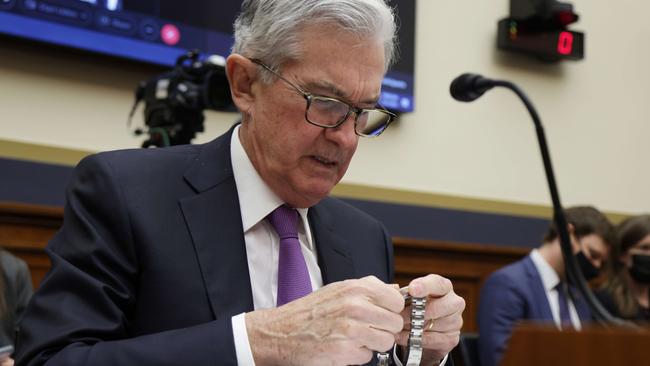Inflation, jobs prompted Jerome Powell pivot
US Fed officials have laid the groundwork to more quickly end a pandemic-era stimulus program at their meeting next week.

Just four weeks ago, the US Federal Reserve set in motion carefully telegraphed plans to gradually wind down a bond-buying stimulus program by June. Officials are making plans to accelerate the process at their policy meeting next week, ending it by March instead.
The abrupt shift opens the door to the Fed raising interest rates in the northern spring rather than later in the year to curb inflation, marking a significant policy pivot by chairman Jerome Powell shortly after US President Joe Biden offered him a second four-year term leading the central bank.
With this move, Mr Powell would be focusing the Fed’s efforts more on restraining inflation and less on encouraging employment to return to its pre-pandemic levels. Inflation has surged this year – to 5 per cent in October from a year earlier, according to the Fed’s preferred gauge – amid strong demand for goods and services and supply-chain bottlenecks associated with reopening the economy. At their December 14-15 meeting, Fed officials also could consider revamping their policy statement to stop characterising higher inflation as “transitory” and to clarify their outlook for interest-rate increases next year. Their new individual projections are likely to show most of them expect more than one quarter-percentage-point increase next year.
“You’ve seen our policy adapt, and you’ll see it continue to adapt,” Mr Powell told politicians during hearings last week.
Mr Powell’s turnabout accelerated over the past month as a slew of new data showed price pressures rising and broadening amid a robust economic recovery, according to public comments and recent interviews.
Just days before the Fed’s November 2-3 meeting, the Labour Department reported that the employment-cost index, a widely watched measure of worker compensation that includes both wages and benefits, rose 1.3 per cent in the third quarter from the second, the fastest pace since at least 2001.
That added to doubts among some Fed leaders over whether their plan to gradually reduce their $US120bn ($170bn) in monthly bond purchases over eight months, ending in June, would be fast enough. They want to conclude the program before raising interest rates. Still, officials approved the plan at the November meeting partly to avoid surprising investors with a faster wind down and creating turbulence in the markets.
Three more reports in the following days added to officials’ concerns that they might be moving too slowly: the Labour Department on November 5 reported strong hiring in October and upward revisions to job gains in prior months without an accompanying increase in the number of Americans looking for jobs. That pushed the unemployment rate down to 4.6 per cent. The rate fell further, to 4.2 per cent, in November. On November 10, a separate report showed inflation pressures had accelerated and broadened in October, defying officials’ forecasts that prices would have peaked by the summer. Finally, on November 16, a report showed consumer spending at retail stores, online sellers and restaurants rose briskly in October. That prompted officials to begin laying the groundwork for Mr Powell’s pivot. “The good news is the economy is roaring back,” New York Fed president John Williams said on November 18.
“We’re having huge gains in employment. Unemployment is falling very quickly.”
On November 19, the same day that Mr Biden called Mr Powell to offer him a second term, Fed vice-chairman Richard Clarida revealed during a question-and-answer session at a research conference that the Fed could consider at its December meeting whether to end the asset purchases sooner than planned.
Mr Powell hinted at the pivot during a White House ceremony on November 22 where Mr Biden announced his reappointment. Then on Capitol Hill last week, Mr Powell said it was time to stop describing inflation as transitory, partly due to differences over what that term means and to underscore greater humility in forecasting.
The Fed still expects inflation to decline next year, but Mr Powell indicated the central bank doesn’t want to bet the farm on it. “Almost all forecasters do expect that inflation will be coming down meaningfully in the second half of next year,” he said. “The point is we can’t act as though we’re sure of that.”
The Fed has moved cautiously this year to withdraw stimulus in part because of a new framework officials adopted last year that set aside the central bank’s longstanding preference for pre-emptively raising rates to head off inflationary pressures. The new framework followed a decade in which inflation had consistently defied expectations that it would rise to the Fed’s 2 per cent goal.
Fed officials last year laid out a test to raise interest rates that would require inflation to reach 2 per cent and be on course to exceed that while the labour market returns to levels consistent with maximum employment.
The Wall Street Journal



To join the conversation, please log in. Don't have an account? Register
Join the conversation, you are commenting as Logout